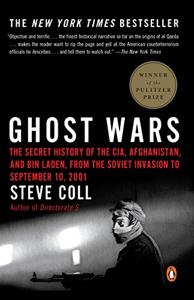
Want to learn the ideas in Ghost Wars better than ever? Read the world’s #1 book summary of Ghost Wars by Steve Coll here.
Read a brief 1-Page Summary or watch video summaries curated by our expert team. Note: this book guide is not affiliated with or endorsed by the publisher or author, and we always encourage you to purchase and read the full book.
Video Summaries of Ghost Wars
We’ve scoured the Internet for the very best videos on Ghost Wars, from high-quality videos summaries to interviews or commentary by Steve Coll.
1-Page Summary of Ghost Wars
Overall Summary
Ghost Wars is a nonfiction book that explores the history of America’s involvement in Afghanistan. The author starts with the Soviet invasion and ends before 9/11. He includes information from interviews, declassified documents, and his own research to tell this story.
The book begins in 1979 with the Soviet invasion of Afghanistan. Several factions revolt against the Soviets, waging guerrilla warfare and receiving support from the United States as part of its proxy war against the Soviets. The rebels receive money, weapons, and training from the CIA to fight back.
As part of the training program for Afghanis, camps were built to help them fight against the Soviets. In these camps, US intelligence agents came into contact with Osama bin Laden, a wealthy Saudi who was funding charities for humanitarian aid and giving financial support to fighters in Afghanistan. The Saudis also wanted to ensure that the Afghans won their war against the Soviets.
The Taliban is one of the fastest growing factions in Afghanistan. They are gaining support from Pakistan and Saudi Arabia, as well as some members of the U.S. government who provide them with funding without telling anyone else about it.
In 1986, the Soviets want to remove their troops from Afghanistan. However, they are worried that without Soviet support, some of the rebel groups in Afghanistan will fight against the government. Both Americans and Soviets fear a civil war between these two groups when Soviet troops withdraw from Afghanistan in 1989. The United States declares neutrality and removes most of its intelligence agents from the region. Eventually, Ahmad Shah Massoud becomes leader of an alliance called Northern Alliance who is pushed into northern regions where he is able to maintain good relations with America but not enough support for fighting Taliban forces.
Bin Laden soon moves to Sudan after criticizing the Saudi royal family. He then makes contact with Taliban leaders and trains terrorists in Afghanistan, a region that was set up by the US government to train soldiers against the Soviet Union.
The United States and the Soviet Union have both left hundreds of anti-aircraft missiles in Afghanistan. Various factions fight over them, and eventually U.S. agents intervene to buy back some of those weapons from Afghan warlords. Meanwhile, the US government establishes an intelligence network dedicated to monitoring radical groups such as the Taliban and al Qaeda in that country.
Throughout the 1990s, bin Laden and the Taliban grow stronger. They continue to send people to Afghanistan for training in terrorism. More terrorist acts around the world are traced back to them, including hotel bombings in Yemen in 1992 and attacks on US embassies in Africa in 1994.
The United States tries to capture or kill bin Laden, but he escapes. He is seen as a serious threat in 1999, but nuclear weapons are more of a concern and the U.S. decides to commit resources to stop their spread. Bin Laden begins planning the September 11 attacks in late 1999.
The CIA receives bits and pieces of information, but they don’t put together a clear picture. The United States is aware that something big is going to happen, but by June 2001 all the terrorists are already in the country waiting for their orders. By September 2001 it’s too late to stop the terrorist attacks since Massoud has been assassinated in Afghanistan.






